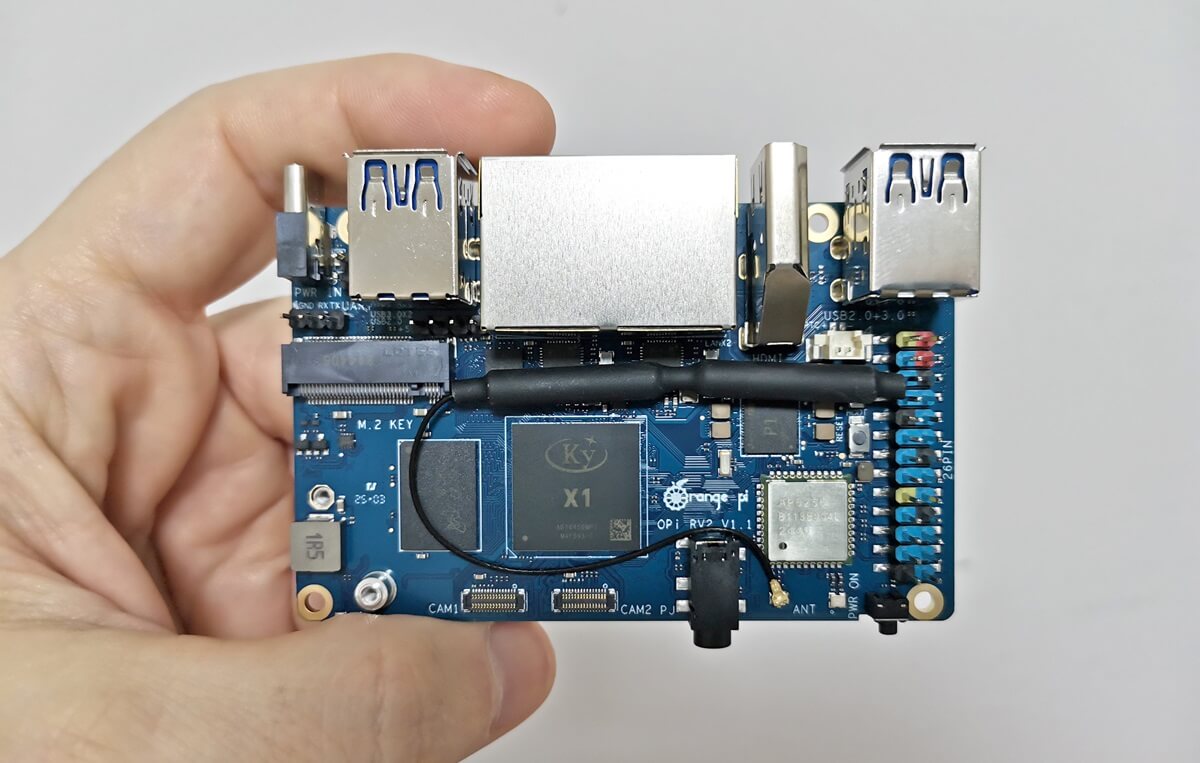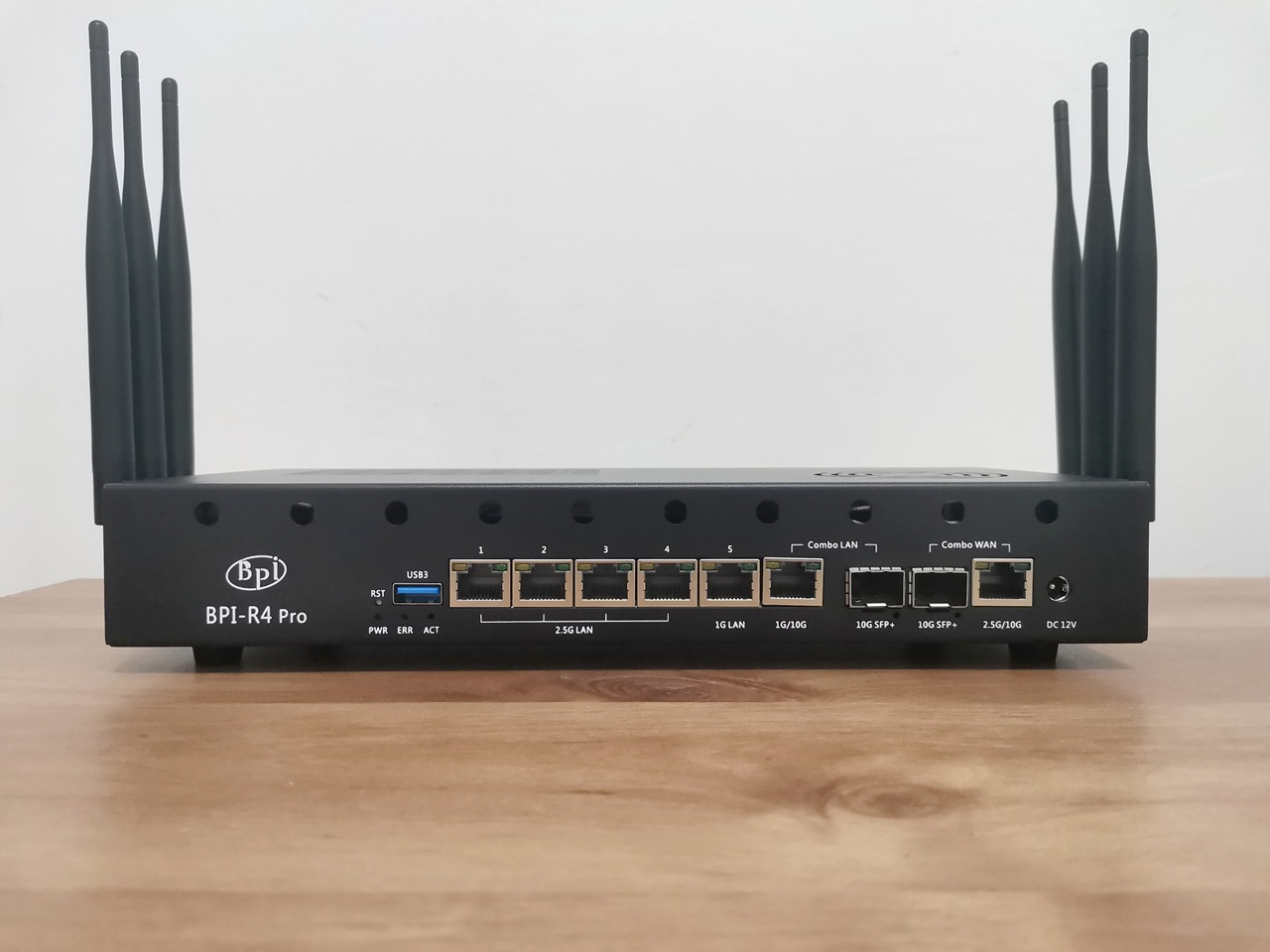The RV2 is a power-efficient, compact single-board computer, making it a great budget-friendly option. Let’s take a closer look at its pros and cons.
- Very low prices (Starting at $30).
- Two M.2 Sockets (2230 & 2280).
- Two 1GbE ports.
- Built-in Wi-Fi support.
- Headphone jack.
- 2TOPS CPU (Optimized for AI Applications).
- eMMC socket (Support eMMC modules).
- HDMI 2.0
- 26-pin header interface.
- USB Ports: 3x USB3.0 + 1x USB2.0
- OpenWrt Support
- No integrated GPU
- No mainline OpenWrt support.
- Maybe you missed it? Orange Pi RV.
- Orange Pi RV2 Review: Introduction, Specs, Features, Interfaces, and Hands-on Testing.
Part 1: Orange Pi RV2 SBC/Router Board | Introduction
The newly released Orange Pi RV2 SBC (single-board computer) is equipped with cutting-edge CPU-fused AI technology, driven by Ky X1 8-core 64-bit RISC-V AI CPU. This low-cost board delivers an impressive AI computing capability of 2 TOPS, enabling rapid deployment of AI model algorithms.
Available in a variety of configurations with LPDDR4X RAM options of 2GB, 4GB, or 8GB. Additionally, it features an optional eMMC module option available in storage capacities of 16GB, 32GB, 64GB, or 128GB. It also supports Wi-Fi 5, Bluetooth 5, and Bluetooth Low Energy (BLE), making it a good choice for a majority of computing applications.
A Quick Product intro
Additional Interfaces
Featuring dual GbE and M.2 slots in one SBC (Single-board computer)
The RV2 boasts an impressive array of interface options, including HDMI 2.0 output, GPIO interface, USB 2.0, USB 3.0, a Gigabit Ethernet port, and a 3.5mm headphone jack. It features two M.2 M-key slots (PCIe 2.0 x2 lanes) for seamless NVMe SSD installation. With its compact dimensions of 89mm x 56mm x 1.6mm, the RV2 combines power and efficiency in a remarkably portable design.
The RV2 is a notable addition to the growing family of single-board computers, specifically designed to cater to the needs of networking enthusiasts and developers. As a RISC-V router board, it stands out in a market dominated by ARM and x86 architectures. RISC-V, an open-source instruction set architecture, offers flexibility and customization, making it an appealing choice for those looking to experiment with networking solutions.
Ky X1 System on Chip (SoC) – Designed for entry-level AI Applications
The Ky X1 System on Chip (SoC) is designed specifically for low-end artificial intelligence, edge computing, and Internet of Things (IoT) applications.
This processor is not equipped with a dedicated graphics processing unit (GPU). While it supports display interfaces like HDMI 2.0 and MIPI DSI for dual-screen setups. The chipset comes with an integrated NPU and is specifically engineered and optimized to function as a gateway router device and is designed for low-power AI computing applications where the demand for GPU performance is minimal.
Key Takeaways
- Powered by a Ky X1 8-core, 64-bit RISC-V AI CPU.
- Embedded 2 TOPS NPU.
- Energy-efficient architecture.
- Different configurations of RAM are available: 2GB/4GB/8GB LPDDR4X.
- Support eMMC module (16GB/32GB/64GB/128GB optional).
- SPI Flash: 128 Mb (default), 256 Mb optional.
- USB Host ports: 1x USB 2.0, 3x USB 3.0, 1xUSB 2.0 (4Pin header).
- 2x M.2 M-key slots (PCIe 2.0 x2 lanes).
- 2x Gigabit Ethernet LAN ports.
- Integrated Wi-Fi 5.0+BT 5.0, with BLE.
- Tested with DeepSeek.
Orange Pi RV2 specs
| Category | Specification |
|---|---|
| CPU | Ky X1 8-core RISC-V AI CPU 2TOPS AI power |
| Memory | LPDDR4X: 2GB/4GB/8GB optional |
| Storage | eMMC module (optional): 16GB/32GB/64GB/128GB SPI FLASH: 128Mb (default), 256Mb optional 2x M.2 M-key sockets: PCIe 2.0, 2x lanes NVMe SSD TF Card: Supports SDIO3.0 TF Card |
| Wi-Fi + Bluetooth | Wi-Fi + Bluetooth 2-in-1 Module: AP6256 Wi-Fi 5 + BT 5.0, BLE |
| Ethernet Interface | 2x Gigabit Ethernet, PHY Chip: YT8531C-CA |
| Display | Supports dual-screen heterodyne display, up to 1920×1440@60fPS 1x HDMI 2.0 1x 4-lane MIPI DSI |
| Camera | 2x 4-lane MIPI CSI camera interfaces |
| USB | 1x USB 2.0 host or device 3x USB 3.0 Host 1x USB 2.0 host (4-pin header) |
| Audio | 3.5mm headphone jack audio input/output HDMI audio output |
| Buttons | 1x BOOT, 1x RESET, 1x POWER ON |
| RTC | 2-pin spare battery connector (Pitch = 1.25 mm) |
| 26Pin | 26-pin function expansion interface, supports the following interface types: GPIO, UART, I2C, SPI, PWM, etc. |
| DEBUG | 3-pin debug serial port, 3.3V level |
| Power Input/Output | Power connector: 2-pin. Maximum 5V, 1A output, such as for connecting a fan. |
| Power Supply | Type-C 5V 5A DC IN |
| PCB Size | 89mm x 56mm x 1.6mm |
| Supported OS | Ubuntu/Debian, OpenHarmony, OpenWrt |
Board interfaces and layout.


A budget-friendly solution for building a router gateway
The RV2 provides an affordable entry point for users interested in building their own routers or exploring the capabilities of RISC-V technology. This board is particularly significant as it represents a shift towards open-source hardware in the networking domain. With the increasing demand for customizable and efficient networking solutions, the board is positioned to meet these needs while remaining budget friendly. The RV2 design is tailored for both hobbyists and professionals, allowing users to leverage its capabilities for various applications, from home networking to more complex enterprise solutions.
Practical Applications
- Machine Learning: Its AI capabilities enable it to perform tasks such as image recognition, natural language processing, and predictive analytics.
- Robotics: The processor’s efficiency and performance are suitable for robotics, supporting real-time decision-making and control.
- Embedded Systems: The hardware can be seamlessly integrated into various devices, including IoT gadgets, smart appliances, and industrial automation systems.
Software Support
The RV2 is designed to support operating systems such as Ubuntu 20.04 and is set to soon offer compatibility with OpenHarmony 5.0, coupled with extensive integration with DeepSeek. Additionally, OpenWrt support is available, positioning it as an optimal solution for functioning as a mesh or access point to enhance Wi-Fi signal coverage.
Main Features of the RV2
Powerful Performance
At its heart, the board is driven by an octa-core RISC-V processor, offering exceptional performance and outstanding energy efficiency.
1. Robust Connectivity Options
The specifications include multiple Ethernet ports, enabling users to set up robust network configurations. Additionally, the board supports various connectivity options, such as Wi-Fi and Bluetooth, enhancing its versatility in different environments.
2. Compact and Versatile Design
The RV2 generally offers adequate RAM and onboard storage options for managing multiple tasks at once. It features a 26-pin function expansion interface and supports various interface types, including GPIO, UART, I2C, SPI, and PWM, enabling users to connect additional peripherals or sensors. Its compact design facilitates integration into existing setups without needing substantial space, suitable for both home and professional applications.
3. Two M.2 Key-M slots on a single board
The Orange Pi R&D team has successfully incorporated two M.2 slots onto the RV2 board while maintaining a compact form factor. The front features a 2230 slot, and a second 2280 slot is located on the rear of the board, providing users with multiple storage options. Additionally, there is an eMMC socket available for attaching modules to the board for further storage capacity, ranging from 16 GB up to 128 GB.
The photos below illustrate two options for adding NVMe SSD cards. It’s important to note that in the front view of the board, the NVMe socket will obstruct the memory chip; therefore, utilizing a thin copper shim for cooling is essential. Alternatively, you could bypass the M.2 M-Key 2230 slot and opt for a larger heatsink that accommodates both the main SoC chip and the RAM chip.
4. Anticipated data transfer speeds
The product specifications indicate that the interface supports PCIe 2.0 x2 lanes. While it may not be the fastest option available, it offers commendable performance for an economically priced board. Each lane of PCIe 2.0 delivers a theoretical maximum bandwidth of 500 MB/s. This means that with two lanes, the total potential bandwidth reaches 1 GB/s (or 1000 MB/s). However, it’s important to note that actual speeds often fall short due to system overhead and inherent inefficiencies.
The RV2 M.2 Slots (Front and Rear View)
Pin Configuration Layout

RISC-V Architecture: The Advantages
Utilizing a RISC-V router board like the Orange Pi RV2 offers several advantages over traditional architectures. One of the primary benefits is the open-source nature of RISC-V, which allows developers to modify and optimize the architecture according to their specific needs. This flexibility can lead to enhanced performance and efficiency in networking applications, as users can tailor the system to their requirements without being constrained by proprietary limitations.
Moreover, RISC-V’s growing ecosystem means that developers can access a wealth of resources, libraries, and community support. This collaborative environment fosters innovation and encourages experimentation, making it easier for users to implement new features or troubleshoot issues. Additionally, the cost-effectiveness of RISC-V boards like this board makes them accessible to a broader audience, promoting the adoption of advanced networking technologies among hobbyists and small businesses alike.






